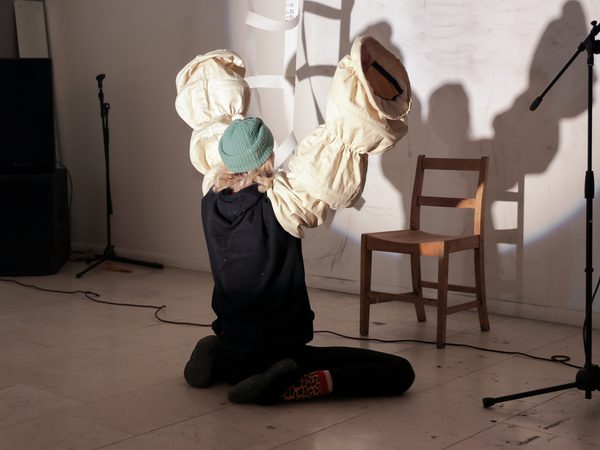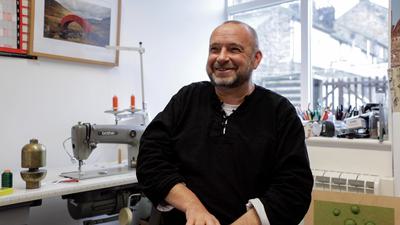What Do Axis Artists Do All Day? Capitol Spaces Cardiff
We journey to Cardiff to talk to some of the artist-led organisations who use our Vacant Spaces in the Capitol Shopping Centre.

Performer at tactileBOSCH, Cardiff
In the film we talk to Beth Greenhalgh from tactileBOSCH, Rey Hope from Dyddiau Du, Paisley Randell Shillabeer from Cardiff Umbrella and Claire Vaughan from SHIFT.
'What do Axis artists do all day?' is a series of films where we take a behind-the-scenes look at an Axis member and their practice. Artists work in all sorts of different ways and in all sorts of different spaces - from kitchen tables and bedrooms to shared studios and even bespoke built sheds! The films offer a rare insight into how artists work, the ideas underpinning their practice and what motivates them to create.
Find out more about the Capitol Spaces
Transcript
tactileBOSCH
tactileBosch started in 2000 and it was in a building in Llandaff.
So it was in an old, laundry building, like, really beautiful warehouse-type building.
And we've been a bit nomadic since losing that space in 2012.
So we've taken on other spaces around Cardiff and we've been here for about six years.
We do lots of different things because we do things through the Arts Council.
So we do exhibitions and residencies, and we've worked with Cadw, which is National Heritage.
So we do lots of things, but we're very interested in live art or presence and needing an audience or a gathering.
And so yeah, so we focus in on sound works, installation, performance art, video work.
We like to create kind of an experience so it's like you come to a show and it takes you on a journey, you know, like, yeah, it's like a mix match.
So you have things next to each other, like someone’s sound interrupts someone's performance and it's like a nice soup of happening I guess.
It's really nice to have a big space like this, we’re so central.
So, you know, if you do anything here and you want to share, it's so accessible.
It's really easy to get here.
There is a community here as well, with having all the other spaces and being able to do things in Shift or Shift do things here or similar with Umbrella, you know, there’s a really joyous energy and you do feel really held and you feel really witnessed, I guess, which is really nice.
Cons, there probably are some, I suppose it's the nervous thing of losing a space and what that would do to the artists that you facilitate and where on earth you’d put all the stuff that you have and, you know, just that kind of yeah, just losing that safety net of having somewhere that you can come and make work or you can just come and have a chat and you can just come and just be, you know, and use the space yeah and just be creative.
Dyddiau Du
Yeah it came about originally wanting to have a space for a little sort of self-sustaining bookshelf and very quickly grew and grew, we were really lucky to be able to have access to this space and realising that there was a real gap for queer and neurodivergent communities.
There's not a lot of spaces that are purpose built or given over to those groups of people.
We've got a community library here. And in the daytime, we tend to have an open space for co working, which we find really beneficial for neurodivergent people to be able to body double, and sit with someone while you work.
We also do events and workshops like open mics, run a monthly collage club, which is just like a really friendly space to sort of relax and do some nice, little crafty bits together.
The space is really great in that it is so central so the accessibility of that is much higher than a lot of art spaces get tucked away in corners.
So yeah, being able to be right kind of on the high street is really beneficial.
We have so much space in this room, we've got lots of tables for working.
We've got a massive space for the library and also a big open space that we can utilise for events and stuff.
I suppose the name in itself, Dyddiau Du is Welsh for dark days, it’s a bit of a cheeky way of being like things might not always be great outside, but this is a place you can be safe, you can be yourself, being a space that it is just safe to exist in without demanding too much of you.
Cardiff Umbrella
Cardiff Umbrella is an art space but mostly we're a group of people that inhabit a space in the Capitol Centre at the moment and we're trying to build a very open place that people feel like they can access the arts.
And I think that when I wanted to access the arts myself, when I moved back to Cardiff, I felt a little bit isolated about how I might get back into things. So I created something that I hope would be useful for artists themselves.
So it's sort of a queer-led, artist-led group of people. And we've got a lot of people that are involved in the shows that we build.
We do open calls, we've done shows in other buildings and other spaces.
We run workshops and we have lots of different events and show openings, and we try to keep them community-focused so they're not solo shows they’re more about what we can do to help the community.
I think one of the best things about being in the building at the moment is that we've built such an incredible community of artists. I mean, it's just so wonderful to feel like there are people doing exciting things all around you and you're not isolated, and that can really help us when we're trying to move forward with the work that we're doing.
I don't think we would have lasted as long had we been just by ourselves, and that sense of community, we meet up every week and we chat and we make decisions about what we're going to do next, and we continue to support each other. And that's been so useful. And having a physical space, there's nothing like it because you can do so much with that.
You can have exhibitions, you can invite people in, you can let them use the space, we can say yes to so many things that we wouldn't be able to say yes to had we not had a space.
And I know that this space would not be being used either. So it feels like such a privilege to be able to do that.
Maybe the cons of being in a space is that sometimes you get tied to a space and you feel as though there's not much room for exploration. And I tend to focus on a lot of what's happening at Umbrella, and I sometimes forget about my own practice, and I'm making the time to do that more this year.
Yeah, I can't say that there are many cons, because it's such an important and useful thing that we have.
SHIFT
So, SHIFT we’re an artist collective, we’re an R&D space.
So all the residents who are kind of here, all the work you can see around us, the people working all the way through the week and we present stuff in the the other side of the space.
So we're kind of all about collaboration and we kind of like it's the lovely things that come out of collaboration, and there's a kind of web of collaborations that come out from the residents here and people they know, and they've brought people in.
And that all happens in the performance side of the space.
Yeah, I mean I suppose the thing that links us all together is we're all quite, politically minded in a way that, all of our sort of artistic practice is informed by the space we're in.
I mean, that's why people are here, We’re all really interested in how to kind of rejuvenate our city a little bit, how to make our city livable.
But also there's a lot of sound art here, there's a lot of sound artists who perform here. We're quite interested in performance arts, in performance practice. But some people, it's just a space that they can help collaborate with others.
So I suppose it all kind of grows out from that idea of if we all want the best for our city and we want the best for other artists. So it all grows from there I think.
It's a strange space because obviously it's quite cavernous when you come down here at first. And so it sometimes does freak people out when they want to do an event. It’s like, oh my God, I can't possibly think about how I can use this space. But actually, it’s got all these little surprises, the space has got all these little surprises.
One of our sound artists, our associate artists Chris Parfitt that comes in, he's done sound all over the world, worked in acoustic spaces all over the world. And this is a really interesting acoustic space. He's recording in different corners and the concrete brings out this kind of warmth sound.
So like I say, we really like it, you know, there's these weird little surprises in the building that you wouldn't know that are there. And like I say, we do manage to fill it.
The space is quite interesting, just the idea of negative space is quite interesting in this space as well.
So yeah, we love it here.
Tags, Topics, Artforms, Themes and Contexts, Formats
Share this article
Helping Artists Keep Going
Axis is an artist-led charity supporting contemporary visual artists with resources, connection, and visibility.

